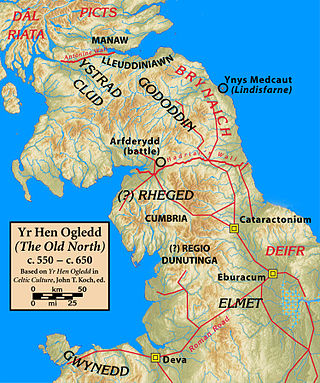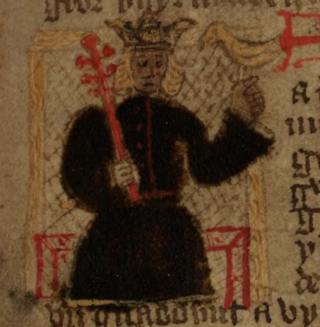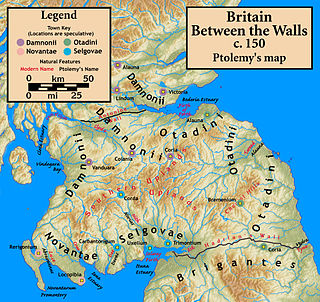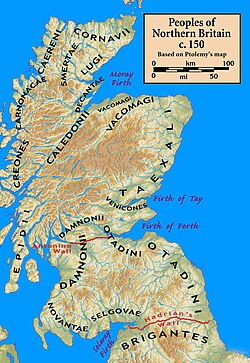
The Gododdin were a Brittonic people of north-eastern Britannia, the area known as the Hen Ogledd or Old North, in the sub-Roman period. Descendants of the Votadini, they are best known as the subject of the 6th-century Welsh poem Y Gododdin, which memorialises the Battle of Catraeth and is attributed to Aneirin.

Rhodri ap Merfyn, popularly known as Rhodri the Great, succeeded his father, Merfyn Frych, as King of Gwynedd in 844. Rhodri annexed Powys c. 856 and Seisyllwg c. 871. He is called "King of the Britons" by the Annals of Ulster. In some later histories, he is referred to as "King of Wales", although the title is anachronistic and his realm did not include southern Wales.
Maelgwn Gwynedd was king of Gwynedd during the early 6th century. Surviving records suggest he held a pre-eminent position among the Brythonic kings in Wales and their allies in the "Old North" along the Scottish coast. Maelgwn was a generous supporter of Christianity, funding the foundation of churches throughout Wales and even far beyond the bounds of his own kingdom. Nonetheless, his principal legacy today is the scathing account of his behavior recorded in De Excidio et Conquestu Britanniae by Gildas, who considered Maelgwn a usurper and reprobate. The son of Cadwallon Lawhir and great-grandson of Cunedda, Maelgwn was buried on Ynys Seiriol, off the eastern tip of Anglesey, having died of the "yellow plague"; quite probably the arrival of Justinian's Plague in Britain.

The Annales Cambriae is the title given to a complex of Latin chronicles compiled or derived from diverse sources at St David's in Dyfed, Wales. The earliest is a 12th-century presumed copy of a mid-10th-century original; later editions were compiled in the 13th century. Despite the name, the Annales Cambriae record not only events in Wales, but also events in Ireland, Cornwall, England, Scotland and sometimes further afield, though the focus of the events recorded especially in the later two-thirds of the text is Wales.
Pictish is the extinct Brittonic language spoken by the Picts, the people of eastern and northern Scotland from Late Antiquity to the Early Middle Ages. Virtually no direct attestations of Pictish remain, short of a limited number of geographical and personal names found on monuments and early medieval records in the area controlled by the kingdoms of the Picts. Such evidence, however, points strongly to the language being an Insular Celtic language related to the Brittonic language spoken prior to Anglo-Saxon settlement in what is now southern Scotland, England, and Wales.

Cunedda ap Edern, also called Cunedda Wledig, was an important early Welsh leader, and the progenitor of the Royal dynasty of Gwynedd, one of the very oldest of western Europe.
Ceredig ap Cunedda, was king of Ceredigion in Wales.
Cadafael ap Cynfeddw was King of Gwynedd. He came to the throne when his predecessor, King Cadwallon ap Cadfan, was killed in battle, and his primary notability is in having gained the disrespectful sobriquet Cadafael Cadomedd.

The Votadini, also known as the Uotadini, Wotādīni, Votādīni, or Otadini were a Brittonic people of the Iron Age in Great Britain. Their territory was in what is now south-east Scotland and north-east England, extending from the Firth of Forth and around modern Stirling to the River Tyne, including at its peak what are now the Falkirk, Lothian and Borders regions and Northumberland. This area was briefly part of the Roman province of Britannia. The earliest known capital of the Votadini appears to have been the Traprain Law hill fort in East Lothian, until that was abandoned in the early 5th century. They afterwards moved to Din Eidyn (Edinburgh).
Iago ap Beli was King of Gwynedd. Little is known of him or his kingdom from this early era, with only a few anecdotal mentions of him in historical documents.
Rhun ap Maelgwn Gwynedd, also known as Rhun Hir ap Maelgwn Gwynedd, sometimes spelt as 'Rhûn', was King of Gwynedd. He came to the throne on the death of his father, King Maelgwn Gwynedd. There are no historical records of his reign in this early age. A story preserved in both the Venedotian Code and an elegy by Taliesin says that he waged a war against Rhydderch Hael of Alt Clut and the kings of Gododdin or Manaw Gododdin. The small scattered settlement of Caerhun in the Conwy valley is said to be named for him, though without strong authority. Rhun also appears in several medieval literary stories, as well as in the Welsh Triads. His wife was Perwyr ferch Rhûn "Ryfeddfawr" and their son was Beli ap Rhun "Hîr".

Cynan Dindaethwy or Cynan ap Rhodri was a king of Gwynedd in Wales in the Early Middle Ages. Cynan was the son of Rhodri Molwynog and ascended to the throne of Gwynedd upon the death of King Caradog ap Meirion in 798. His epithet refers to the commote of Dindaethwy in the cantref Rhosyr. Unlike later kings of Gwynedd, usually resident at Aberffraw in western Anglesey, Cynan maintained his court at Llanfaes on the southeastern coast. Cynan's reign was marked by a destructive dynastic power struggle with a rival named Hywel, usually supposed to be his brother.
Merfyn Frych, also known as Merfyn ap Gwriad and Merfyn Camwri, was King of Gwynedd from around 825 to 844, the first of its kings known not to have descended from the male line of King Cunedda.
The Novantae were a people of the late 2nd century who lived in what is now Galloway and Carrick, in southwesternmost Scotland. They are mentioned briefly in Ptolemy's Geography, and there is no other historical record of them. Excavations at Rispain Camp, near Whithorn, show that it was a large fortified farmstead occupied between 100 BC and 200 AD, indicating that the people living in the area at that time were engaged in agriculture.

Hywel ap Rhodri Molwynog as he was improperly called due to lack of knowledge of the genealogies by men like John Edward Lloyd, but in fact was Hywel ap Caradog was King of Gwynedd. He rose to power following a destructive dynastic struggle in which he deposed his cousin, King Cynan Dindaethwy ap Rhodri. During Hywel's reign Gwynedd's power was largely confined to Anglesey. It was a time of substantial territorial loss to Mercia.

Yr Hen Ogledd, or in English the Old North, is the historical region that was inhabited by the Brittonic people of sub-Roman Britain in the Early Middle Ages, now Northern England and the southern Scottish Lowlands, alongside the Celtic Kingdom of Elmet. Its population spoke a variety of the Brittonic language known as Cumbric which is closely related to, if not a dialect of Old Welsh. The people of Wales and the Hen Ogledd considered themselves to be one people, and both were referred to as Cymry ('fellow-countrymen') from the Brittonic word combrogi. The Hen Ogledd was distinct from the parts of North Britain inhabited by the Picts, Anglo-Saxons, and Scoti.

Lloegyr is the medieval Welsh name for a region of Britain (Prydain). The exact borders are unknown, but some modern scholars hypothesize it ran south and east of a line extending from the Humber Estuary to the Severn Estuary, exclusive of Cornwall and Devon. The people of Lloegyr were called Lloegyrwys without distinction of ethnicity, the term applying to both Britons and Anglo-Saxons.

Aeron was a kingdom of the Brythonic-speaking Hen Ogledd, presumed to have been located in the region of the River Ayr in what is now southwestern Scotland. It existed during the post-Roman era, perhaps earlier, and disappeared before or during the 7th-century conquest of the region by the ascendant Kingdom of Northumbria.
Gwriad ap Elidyr or Gwriad Manaw was a late-8th century figure in Wales. Very little is known of him, and he chiefly appears in the historical record in connection to his son Merfyn Frych, King of Gwynedd from around 825 to 844 and founder of the Merfynion dynasty.

Eidyn was the region around modern Edinburgh in Britain's sub-Roman and early medieval periods, approximately the 5th–7th centuries. It centred on the stronghold of Din Eidyn, thought to have been at Castle Rock, now the site of Edinburgh Castle, and apparently included much of the area below the Firth of Forth. It was the most important district of the Brittonic kingdom of Gododdin, and a significant power in the Hen Ogledd, or Old North, the Brittonic-speaking area of what is now southern Scotland and northern England.











